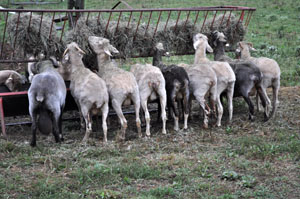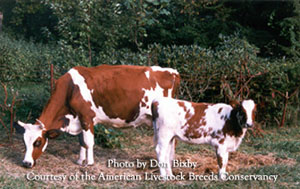Posted by · Leave a Comment
Take a walk in tall grasses this time of year and you’ll likely pick up all sorts of hitchhikers (yes, we called them “hitchhikers” as kids) As a mom, I tend to find these indoors more than out: on socks, coveralls, the dryer lint screen, bath towels.
The typical varieties around here are Agrimony and Tall Beggar’s Ticks.
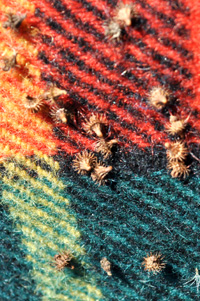
Agrimony Seeds
Agrimony’s aliases should clue us in: “Cockeburr,” “Sticklewort,” “Philanthropos” (maybe because it gives freely of its seeds?). It’s a lovely native plant—with tall, showy spikes in the late summer. The seeds rely on passersby (human and/or animal) to pick up and unknowingly deposit them elsewhere.
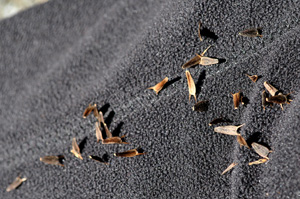
Tall Beggar's Ticks
Tall Beggar’s Ticks have unique prongs which grab at any soft material—a shirt, dog hair, etc. Nathaniel, my son, upon seeing the collection on my pants promptly said, “Mom, pull those out gently because if the spikes break in the material, it’ll bother you for days!” I agreed. Just one plant can yield hundreds of prickly-pronged seeds.
In 1941, a Swiss engineer returned from a walk with his dog and found burdock seeds lodged in the animal’s fur. After careful microscopic scrutiny, he became fascinated by the “hook and loop construction” that he saw. Do you know what he invented?
Velcro.

 I hadn’t made apple butter for years before this Fall (and I LOVE apple butter!).
I hadn’t made apple butter for years before this Fall (and I LOVE apple butter!).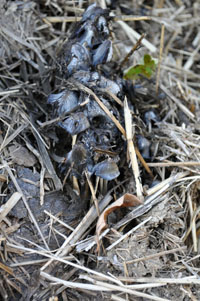 “Quick—get your camera and meet me down where we piled the sheep manure!”
“Quick—get your camera and meet me down where we piled the sheep manure!”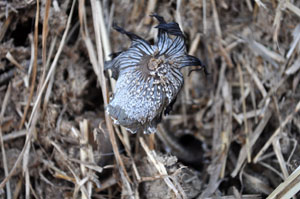
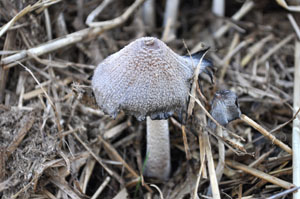 If you’ve ever noticed a small collection of colored “dust” on a leaf or piece of bark near mature mushrooms, you’ve probably witnessed a “spore print.” These are spores which have been released by the mushroom. The Coprinoid caps actually begin in an oval shape and as they mature, the gills liquefy, gently disintegrating. This is their method of reproducing; the spores are picked up and deposited by the wind.
If you’ve ever noticed a small collection of colored “dust” on a leaf or piece of bark near mature mushrooms, you’ve probably witnessed a “spore print.” These are spores which have been released by the mushroom. The Coprinoid caps actually begin in an oval shape and as they mature, the gills liquefy, gently disintegrating. This is their method of reproducing; the spores are picked up and deposited by the wind. 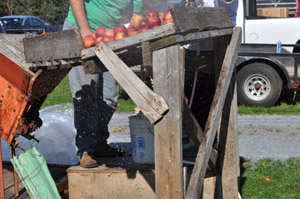 It was really something to behold. Buckets of apples were dumped and washed on the tray, then gently guided into one of the holders which made its way up the conveyor. They were milled at the top and the scratting collected until a handle released it onto the thick cloth lining a wood tray. Each tray’s cloth was folded over before another tray was placed on top. When a handful of trays had been stacked, the apples were pressed and the cider flowed!
It was really something to behold. Buckets of apples were dumped and washed on the tray, then gently guided into one of the holders which made its way up the conveyor. They were milled at the top and the scratting collected until a handle released it onto the thick cloth lining a wood tray. Each tray’s cloth was folded over before another tray was placed on top. When a handful of trays had been stacked, the apples were pressed and the cider flowed!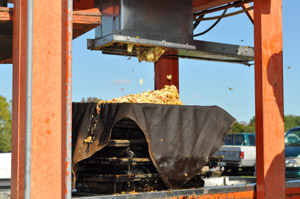
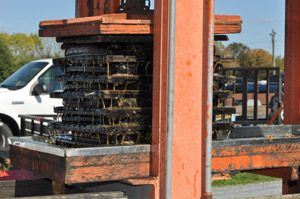 People (as well as bees) gathered to watch the process and, of course, have a taste. Imagine what this would have meant to a community hundreds of years ago…celebrating a summer’s worth of hard work, welcoming fall, and a delicious reason to gather.
People (as well as bees) gathered to watch the process and, of course, have a taste. Imagine what this would have meant to a community hundreds of years ago…celebrating a summer’s worth of hard work, welcoming fall, and a delicious reason to gather.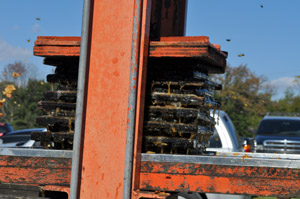
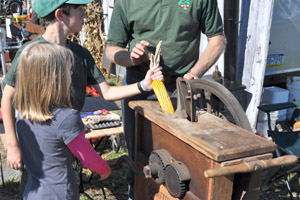 As we strolled past a corn sheller, the gentleman operating it pointed to Nathaniel and said, “Young man, your mom wants to make corn bread!!” Nathaniel looked up, quizzingly, as the man repeated, “she needs your help—go on out and gather a bushel of corn.”
As we strolled past a corn sheller, the gentleman operating it pointed to Nathaniel and said, “Young man, your mom wants to make corn bread!!” Nathaniel looked up, quizzingly, as the man repeated, “she needs your help—go on out and gather a bushel of corn.”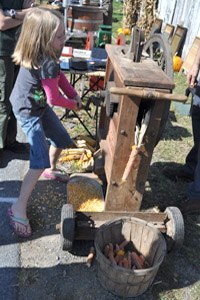
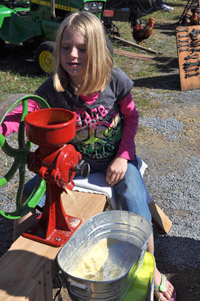 You can imagine they were both smiling by now as Natalie cranked the wheel and Nathaniel added the corn. Once the mill chewed the kernels off, they began spilling out the chute.
You can imagine they were both smiling by now as Natalie cranked the wheel and Nathaniel added the corn. Once the mill chewed the kernels off, they began spilling out the chute.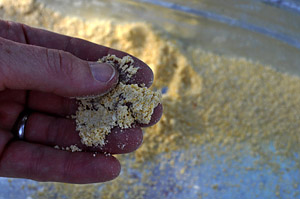 So they gathered the kernels and put them down the mill chute and began to crank. The bowl caught the light, yellow, cracked and milled corn.
So they gathered the kernels and put them down the mill chute and began to crank. The bowl caught the light, yellow, cracked and milled corn.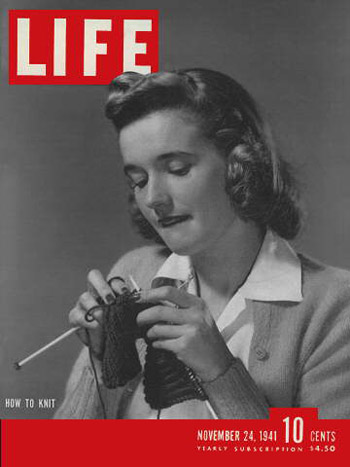 It’s November, 1941.
It’s November, 1941.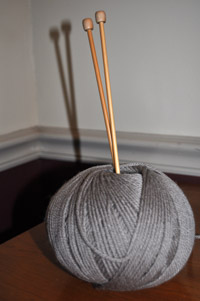 So, you see, knitting, most definitely, has a special place in our history. Whether you knit for fun or for “a purpose,” it’s a skill well worth pursuing.
So, you see, knitting, most definitely, has a special place in our history. Whether you knit for fun or for “a purpose,” it’s a skill well worth pursuing.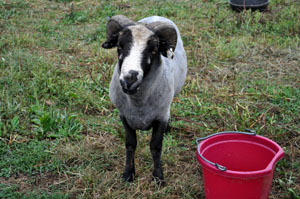 Baw Blue, our devilishly handsome Navajo-Churro ram will return to his home farm in a few days. We heeded his owner’s warning and gave him full and free access to the girls. (Translation: we did not venture into the pasture while he was here except for feeding and watering. Blue’s known to be quite territorial when it comes to his “girlfriends.”)
Baw Blue, our devilishly handsome Navajo-Churro ram will return to his home farm in a few days. We heeded his owner’s warning and gave him full and free access to the girls. (Translation: we did not venture into the pasture while he was here except for feeding and watering. Blue’s known to be quite territorial when it comes to his “girlfriends.”)